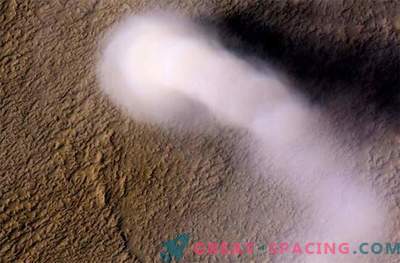
Some Mars experts are looking forward to the arrival of a dust storm this year. It must be so huge that it will cover the entire planet. This phenomenon can be considered with the help of spacecraft located on Mars.
In a new study, scientists re-examined the observations of the MRO orbital apparatus during the last dust storm event in 2007 on Mars. It is believed that these storms play an important role in the process of removing gas from the tops of the atmosphere, because of which the ancient wet planet turned into a desert.
It turned out that in the middle atmospheric layer there is an increase in the amount of water vapor due to dust storms. Water vapor rises with the same air mass as dust. The connection between the presence of water vapor in the average Martian atmosphere (50-100 km) and the leakage of hydrogen was discovered by the Hubble Space Telescope and Mars Express. In 2014, the mission MAVEN arrived in Mars to study in detail the process of escaping gas from the atmosphere.
Researchers hope that the storm of 2018 will surpass all previous ones and cover the planet. However, not all scientists share this position. They remind you that tools and vehicles are on Mars, and a global storm can disrupt their work.
Ten-year observations of Mars helped to compile a picture of numerous regional dust storms that appear during the period of northern spring and summer. At the moment of the Martian summer, all regional storms dissipate and none of them falls into the global one. However, this “rule” was violated in 1977, 1982, 1994, 2001 and 2007. It is expected that the next dust season will begin this summer and last until the beginning of 2019. The MRO has a Mars Climate Sounder that can scan the atmosphere to detect dust and ice particles, and also indirectly determines the concentration of water vapor. The echo sounder data shows a slight increase in water vapor in the middle atmosphere during the period of dust storms and a sharp jump in altitude reached by water vapor during the 2007 global storm.
Prior to the arrival of MAVEN, researchers believed that the loss of hydrogen was steady, and the changes were due to changes in the solar wind flow. But further information did not fit the usual pattern. It turned out that there is a connection not with solar activity, but with the seasonality of the planet.
Future observations will help to improve the understanding of this connection and to understand what the climate would be like if the planet became much windier. No one can say yet whether there were much more dust storms before, or that it was their influence that caused the outflow of gas from the atmosphere. So the event of this year can answer many questions.











































